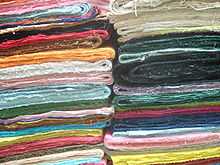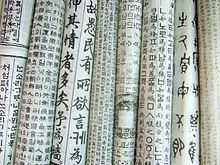Korean paper
| Korean paper | |
 | |
| Korean name | |
|---|---|
| Hangul | 한지 |
| Hanja | 韓紙 |
| Revised Romanization | hanji |
| McCune–Reischauer | hanji |
Korean paper or hanji is the name of traditional handmade paper from Korea.[1][2] Hanji is made from the inner bark of Paper Mulberry, a tree native to Korea that grows well on its rocky mountainsides, known in Korean as dak. The formation aid crucial to making hanji is the mucilage that oozes from the roots of Hibiscus manihot. This substance helps suspend the individual fibers in water.
These methods are similar to those used in Japan to make washi but differ in sheet formation techniques (traditional hanji is made in laminated sheets using the we bal method, which allows for multi-directional grain)[3] and calendering (dochim is a method of pounding finished sheets to compact fibers and lessen ink bleed).[4][5][6][7][8]
History
Ancient
In Korea, papermaking started not long after its birth in China. At first, made crudely out of hemp and ramie scraps (called maji; Korean: 마지), hanji developed to the point that it was renowned as the highest quality paper available in East Asia. Its origins in Korea are believed to fall somewhere between the 200s and the end of the 500s. In 1931, a piece of hanji was found at an archeological dig at a tomb site from the Lelang period (108 BCE–313 CE).
During the Three Kingdoms period (57 BCE–668 CE), each kingdom used paper to record their official histories. In 610, The Buddhist monk Damjing whom Goguryeo presented to Japan was able to make the production method of paper and ink.[9] The world’s oldest surviving wood block print is the Buddhist Dharani Sutra called the Pure Light Dharani Sutra (Korean: 무구정광대다라니경; Revised Romanization: Mugujeonggwangdaedaranigyeong). Listed as Korea's National Treasure No. 126, it was printed onto hanji c. 704 and is still in good condition, bearing the papermaker’s name. Paper crafts were also developed in the Three Kingdoms period, such as kites and other household items, and continued to flourish as hanji production increased.
Goryeo period

Hanji’s golden age peaked in the Goryeo period (918–1392), which saw the rise in quality and use of hanji in conjunction with printmaking. Paper was used to make money, Buddhist texts, and medical and history books. The government encouraged dak cultivation and paper production, and dak was planted countrywide in the 1100s. Often called Goryeoji, hanji became famous in Asia for its strength and luster, and became a heavy trade item to China.
The Goryeo period is famous for two major landmarks in Korean printmaking and paper history. One was the carving of the Tripitaka Koreana onto over 80,000 wooden blocks, which contain no errors and are still extant in their original home at Haeinsa, a Buddhist temple in Gyeongsangnam-do. It was carved twice, due to its destruction by Mongol invasions in 1232; the final version was completed in 1251. The second accomplishment was the printing in 1377 of Jikji, a guide for students of Buddhism, and the world’s oldest extant book printed using metal movable type. Printed onto hanji, it is housed today in the National Library of France, and displays proof of movable metal type well before Gutenberg’s time.
Joseon period
The beginning of the Joseon period (1392–1910) saw continued flourishing of the hanji industry as paper permeated daily lives of Koreans through books, household items, and popular items such as fans and tobacco pouches. From the start of the Joseon period in an effort to promote austerity, artificial flowers that had been made from wax and silk were replaced by paper versions. Later, paper flowers were also used to replace other versions for Buddhist rites and festivals.
Variations of hanji became common, such as colored paper, and paper made from mixed fibers including pine bark, rice straw, and bamboo. This came partly from a need to find new materials beyond dak due to the huge demand for books. The government created an administrative agency devoted to paper production, and also supplied troops with paper armor, which was waterproof, a good insulator, and provided protection against arrows and swords. Oiled hanji was used to make greenhouses c. 1450 because the paper, made of natural materials, could control temperature, humidity, and light effectively. However, the Joseon government pressured Buddhist monks to increase their production of hanji that they were already making for Buddhist scriptures since the 15th century.
As the final blow to hanji, western methods of paper mass production were introduced in 1884.
Japanese occupation
The Japanese occupation (1910–1945) also undermined hanji manufacture as it suppressed Korean culture in general, and machine-made paper’s cheapness and wide availability undercut hanji dramatically.
After liberation
In the 1970s, the New Village Movement that aimed to modernize Korea rapidly also led to further decimation of the hanji industry, as it eradicated traditional straw-thatched homes that used hanji to cover floors, walls, ceilings, windows, and doors. The most recent threat to the Korean paper industry is the rise of inexpensive paper made in China, where labor costs and overhead are significantly lower than in Korea.
As of 2009, twenty-six hanji mills remain operational in South Korea. They make hanji for artists, calligraphers, conservators, temples, and laypeople.[10][11][12][13][14][15]
Hanji art and craft forms
There are two divisions of hanji art: two dimensional and three dimensional. Two-dimensional hanji art uses paper of various colors to create an image in a similar format as a painting, however the paper itself is folded and crumpled to make the image stick up from the paper it is adhered to, but the image itself is only a two-dimensional likeness, although there may be depth to some of the elements. Two-dimensional hanji art can be framed much like a painting. Three-dimensional hanji art is similar to paper mache, in that it can make sculptural objects that may stand unsupported.
Traditional hanji craft forms include jiho, jido, and jiseung. Jiho is a method that uses hanji scraps soaked in water and then added to glue, making a clay-like paste that can be molded into lidded bowls. Jido is the craft of pasting many layers of hanji onto a pre-made frame, which can be made into sewing baskets and trunks. Jiseung is a method of cording and weaving strips of hanji to make a wide array of household goods, including trays, baskets, mats, quivers, shoes, washbasins, and chamberpots.[16]
Gallery
-

Changhoji pasted on doors at Changgyeonggung
-

Hangul printed on hanji at a store in Insadong, Seoul
-

Colorful hanji strings; fans
-

A piece of hanji artwork
-

Modern Hanji Lamp
See also
- Important Intangible Cultural Properties of Korea
- History of typography in East Asia
- Oatmeal paper
References
- ↑ http://www.korea.net/korea/event_board_view.asp?board_no=810&page=7
- ↑ http://www.aks.ac.kr/glossary/glossary_detail.asp?g_code=6573&page=1&c_code=&search_field=all&keyword=hanji&order=g_korean&kanada=
- ↑ Lee, Aimee. “Searching for Yupmuljil in the Korean Countryside,” Kami Newsletter, No. 4. Poking, Kapangan, the Philippines: Asa Press (CP), 2009.
- ↑ Traditional Korean Papermaking: analytical examination of historic Korean papers and research into history, materials and techniques of traditional papermaking of Korea, 2003, the research paper of the Getty Postgraduate Fellow, Hyejung Yum
- ↑ Permanence, Durability and Unique Properties of Hanji by Minah Song and Jesse Munn
- ↑ What's Hanji by FIDES International
- ↑ Making Hanji by FIDES International
- ↑ History of Hanji by FIDES International
- ↑ 『日本書紀(Nihon Shoki)』巻二十二 推古紀 "十八年春三月 高麗王貢上僧 曇徵 法定 曇徵知五經 且能作彩色及紙墨 并造碾磑 蓋造碾磑 始于是時歟"
- ↑ Lee, Aimee. “Buddhist Illumination of Korean Papermaking’s Past and Present”, Buddhism and Culture Magazine, No. 5, April 2010.
- ↑ Amlie, Lynn. "Hanji: Korea's Traditional Paper", Hand Papermaking, Vol. 11, No. 2, Winter 1996.
- ↑ Field, Dorothy. Paper and Threshold: The Paradox of Spiritual Connection in Asian Cultures. Ann Arbor: The Legacy Press, 2007.
- ↑ Field, Dorothy. "Kim Yeong Yon: A Korean Papermaker", Hand Papermaking, Vol. 2, No. 1, Summer 1987.
- ↑ Shimura, Asao. "Papermaking in Korea", Kami '89. The Philippines: Cannabis Press, 1992.
- ↑ Sun, Jai-kyu. “100 uses for hand-made paper: Product of ancient Korean art valued for texture, durability”. The Korea Herald. 19 April 1984.
- ↑ Korean Paper Crafts
External links
| Wikimedia Commons has media related to Hanji. |
- Hanji (Traditional Korean paper) at Korea Tourism Organization
- Fabulous Hanji (Korean Traditional Paper) at Korea Tourism Organization
- Traditional Culture Hands-on Programs at Korea Tourism Organization
| ||||||||||||||||||||||||||